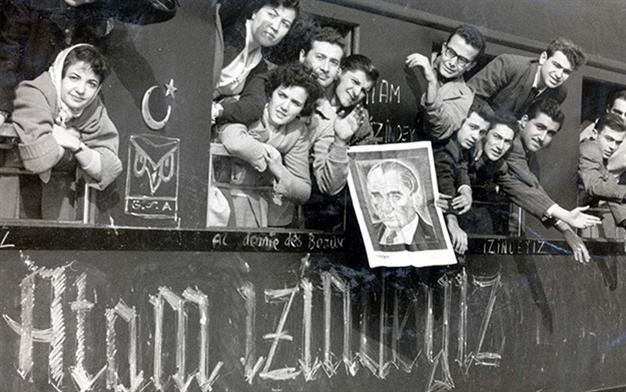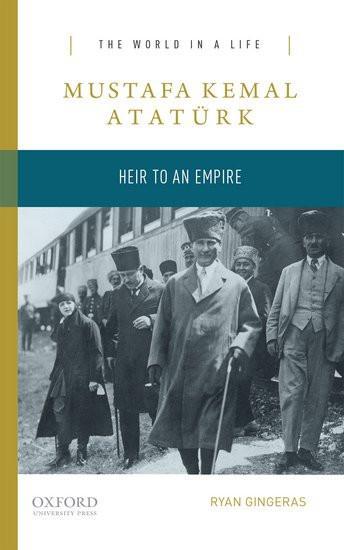Atatürk: Heir to an empire
William Armstrong - william.armstrong@hdn.com.tr

University students in Istanbul travel to Mustafa Kemal Atatürk's state funeral in Ankara in 1938.
‘Mustafa Kemal Atatürk: Heir to an Empire’ by Ryan Gingeras (Oxford University Press, 212 pages, $17)With Mustafa Kemal Atatürk, things are not nearly as clear-cut as either his most ardent admirers or fiercest detractors would like to believe. To the former, the founder of the Turkish Republic was a visionary who single-handedly dragged Turkey from the abyss. To the latter, he was an anti-democratic authoritarian who wrought lasting damage by cutting Turkey off from its Ottoman heritage.

The reality is more complicated. One of the mistakes made by both sides is to suggest that Atatürk’s revolution was a bolt out of nowhere. Against the ideologues, many scholars have in recent decades emphasized historical continuities from the Ottoman to the republican periods. The roots of Westernization, military reform, language reform, and secularist modernization can be traced to the latter years of the Ottoman Empire. While spectacular on paper, the Kemalist program actually built on foundations that went back decades into the Ottoman era.
In this new biography of Atatürk, scholar Ryan Gingeras emphasizes these continuities while also recognizing the huge changes introduced by the early republic. The book adds little original research, but it is a balanced, elegantly written synthesis of existing work. At fewer than 200 pages, it is an excellent introduction to the subject.
One key area of continuity was how the early Turkish Republic largely followed the trajectory established by the Committee of Union and Progress (CUP), also known as the Young Turks. The generals of the CUP had led a revolution forcing Ottoman Sultan Abdülhamit II to accept constitutional rule in 1908, prioritizing the survival of the state through modernization. The CUP was in charge through the First World War and Mustafa Kemal was a member. But his lack of seniority benefited him later on. While distinguishing himself as a brave general in the defense of Gallipoli and on the Middle Eastern front, he was distanced from CUP commanders whose reputations were ruined by the conflict. This gave him political capital that would help him lead the resistance against the punishing conditions imposed by the post-war Treaty of Sevres of 1920.
The triumphant nationalist forces declared the Republic of Turkey in 1923. With its capital in the Anatolian city Ankara, the new regime symbolized a radical new beginning in a landscape exhausted by 12 years of continuous war. Its program replaced religious law with civil law, recognized women’s rights, abolished the sultanate and caliphate, reformed the Turkish language, and decreed what clothes were and were not permitted. Like all senior administrators in the late Ottoman period, Atatürk believed that modernization equaled centralization. Stung by the empire’s torturous decline, he had a profound sense that centralization was the only guarantor of territorial integrity. When the newly established Grand National Assembly met in 1924 to finalize the republic’s constitution, “assembly members refused to implement any framework for provincial autonomy in any portion of Turkey.”
Ironically considering the secularist agenda, Muslimness was the main criteria for citizenship in the new Turkish Republic, hence the population transfers of non-Turkish speaking Muslims to Anatolia from Greece and elsewhere. In line with Mustafa Kemal’s straightforward positivist mentality, it was expected that non-Turkish speaking ethnic minorities would assimilate to the state-constructed Turkish national identity for their own good. However, the Ankara government faced a series of rebellions - often in Kurdish-populated eastern Anatolia and often crushed with brutal force.
Indeed, the sweeping reforms were pushed by an increasingly hardline administration until Mustafa Kemal’s death in 1938 (he was given the surname Atatürk, “Father of the Turks,” in 1934). Gingeras’ book explains how Atatürk and those around him justified this authoritarianism. Authoritarian governance, it was argued, “could not be decoupled from social or political reform; both served the interest of maintaining a strong, sovereign, and independent state.” For the Kemalists, rapid modernization and secularization were not only desirable – they were absolutely necessary to protect the country’s hard-fought freedom. After the sultan was taken under the control of foreign occupiers in Istanbul from 1918 to 1923, secularism could not be seen as just an elite fad, but as essential to protect the independence and security of the state. Gingeras describes the logic as follows:
Securing the republic and maintaining its independence necessitated radical changes to the mores and institutions that condemned Ottoman Anatolian society to occupation, violence and humiliation in the first place. Advancing a stringently secular agenda was not simply a matter of changing one’s tastes and values for the sake of progress; in Kemal’s estimation, Islam was to be banished from public forums of expression and representation because it was integral to an imperial culture that had corroded or limited the government’s ability to act rationally and effectively.
While “Heir to an Empire” is admirably detailed for a book with such limited space, there are some areas that it could perhaps flesh out a little more. Gingeras’ discussion of the young republic’s economic policies, for example, covers barely a page. Elsewhere, his account of the dissolution of the Free Republican Party in 1930 may place too much blame on Mustafa Kemal, whose idea it was to establish the rival party in the first place and who may not have wanted it to disband under pressure from Prime Minister İsmet İnönü.
But overall this is a terrific introduction to the subject. It is also very fair. “Rather than opine as to whether [Atatürk] was a visionary or monster,” Gingeras writes,
it is perhaps best to view his actions and accomplishments from this era through the lens of his immediate past as well as through the global political context of the interwar period. When one considers his political upbringing as a Young Turk, as well as the approaches of other authoritarian leaders from the immediate postwar years, the Gazi’s many accomplishments and excesses appear less extraordinary and more legible.
This could be seen as a more sophisticated version of the “conditions of the era” (dönemin şartları) defense, often criticized in Turkey for playing down injustices committed by the early republic. But Gingeras certainly does not do that. He simply says Atatürk should be understood according to the standards of his time – a time when authoritarian regimes were the norm across Europe. It would be wrong to either see Turkey’s first president as an immortal symbol of timeless principles, or to judge him against the contemporary standards of the European Court of Human Rights. His strongest devotees and his strongest critics should bear that in mind.

 The reality is more complicated. One of the mistakes made by both sides is to suggest that Atatürk’s revolution was a bolt out of nowhere. Against the ideologues, many scholars have in recent decades emphasized historical continuities from the Ottoman to the republican periods. The roots of Westernization, military reform, language reform, and secularist modernization can be traced to the latter years of the Ottoman Empire. While spectacular on paper, the Kemalist program actually built on foundations that went back decades into the Ottoman era.
The reality is more complicated. One of the mistakes made by both sides is to suggest that Atatürk’s revolution was a bolt out of nowhere. Against the ideologues, many scholars have in recent decades emphasized historical continuities from the Ottoman to the republican periods. The roots of Westernization, military reform, language reform, and secularist modernization can be traced to the latter years of the Ottoman Empire. While spectacular on paper, the Kemalist program actually built on foundations that went back decades into the Ottoman era.